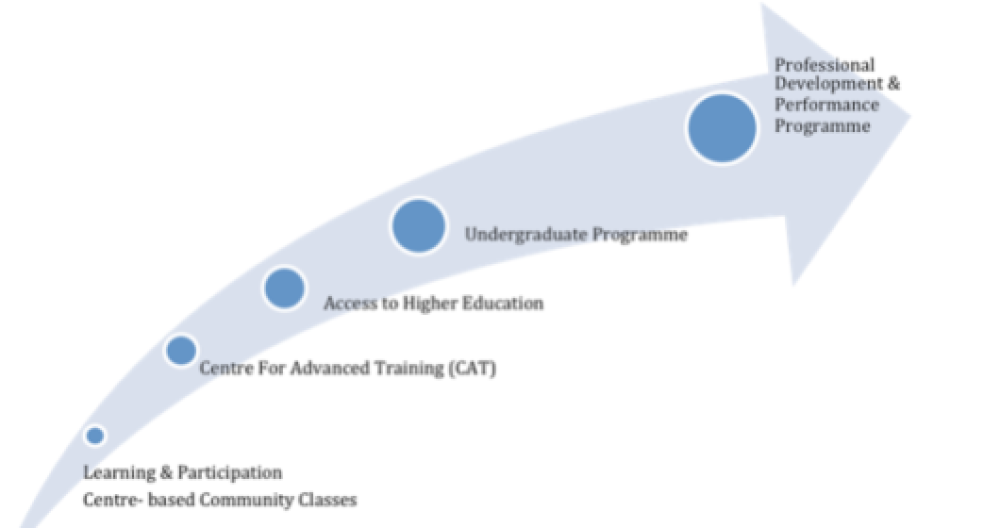

Development of formal dance education in Ireland
‘The Learning Spiral’ is a report by Annette van Zwoll on Janet Smith’s intervention at European Dancehouse Network Atelier on Dance Training, organised at Dance Ireland in Dublin on 29/30 June 2018.
Janet Smith – director of Northern School of Contemporary Dance, Leeds, Great Britain
The Northern School of Contemporary Dance’s mission is to provide different pathways to enable aspiring dance artists, regardless of background or personal circumstances, to shape the future of dance. The NSCD is the only UK conservatoire for dance outside of London, and to fully commit to it’s mission, it has set up an as innovative as effective model to reach potential dance artists way beyond the obvious target groups and support them from pre-vocational training to post graduation. This long-term commitment is called the Learning Spiral, and is a continuous growing and widening body of artists and activities that are all intertwined and connected.
It starts with the Centre for Advanced Training (CAT) that aims to: ‘help identify and assist children with exceptional potential, regardless of their personal circumstances, to benefit from world-class specialist training as part of a broad and balanced education. This will enable them, if they choose to proceed towards self-sustaining careers in dance’
The CAT scheme was launched in 2004 and offers pre-vocational dance training to 13-17 years old. Dance experience is not necessary; enthusiasm, talent, drive, ambition, commitment and determination are the main requirements. Eight hours a week (2 evenings and Saturday), the youngsters receive a highly qualitative dance training focusing on technique, creative dance and choreography, performance, dance health and well being and cultural activities such as theatre and gallery trips, workshops and volunteering opportunities. Successful applicants are able to access highly specialist dance training, whilst continuing living at home. The best thing is: The CAT schemes are funded and free of charge, therefore open to all. And the CAT scheme is performed on a national level, with 12 institutions involved, so also geographically in reach for all as well.
Although usually NSCD expects 80% of the students of CAT to access conservatoire or vocational training, the CAT scheme mainly aims at making talented youngsters aware of their talent and giving them chances to be part of a professional dance education, which can help them in their further careers, whatever they may choose. But how to reach that talent in the first place? (Former) Students of CAT are actively engaged in the Widening Participation Model. They go and teach workshops in schools, and will give out ‘you’ve been spotted’ cards. These cards are a recognition of a kid’s talent and an invitation to apply to the CAT scheme. It’s a way of helping talent coming through. At the same time, activities of CAT are made visible in the different localities by side specific and outdoor projects. An example of this was ‘The Boys project’ in which the male dancers of CAT were presenting mostly urban dance in a shopping mall, connecting to youngsters there and making them aware of the existence of CAT. This peer-to-peer approach has proved to be very effectively.
After the CAT-scheme students can enter a one-year access course in preparation of an in-depth professional study. It focuses on technique, creative and performance experiences, critical and reflective practices and independent study skills. Also here, the connection with secondary schools is intensive, with students providing workshops at schools and with schools coming to performances.

From that, the spiral continues into an undergraduate provision; a 3-year BA programme focusing on the development of versatile, individual dance artists. The BA contains of 5 curriculum strands: technique, creative practice, performance, research and teaching. These students are invited regularly to teach in the CATscheme.
Part of the philosophy of the Learning Spiral is to help and nourish students after their graduation as well. Postgraduates have several pathways to choose. The postgraduate company Verve yearly exists of 14 dances, offering them experience with a wide repertoire of different aesthetics, a broad range of choreographers and national and international touring. Within the company, there is an acceleration of learning and a sharpening of one’s own voice, due to the different aesthetics and working methods offered. NSCD also organizes postgraduate apprenticeships with partner dance companies on a national and international level. The students can follow an apprenticeship that creates possible job opportunities.
Last but not least, NSCD offers a one full-year MA dance & creative enterprise or 2-year part-time programme for graduates as well as professionals on various stages of their career to gain a broader perspective on the arts sector, realise their ideas and find potential markets for their work.
Again, students in the post-graduating pathways are invited to teach at the CATscheme or the BA. This is part of the spiralling: on every level student teach on other levels. This not only enhances ones teaching capabilities, but also creates a vital community of peers, a local ground for dance and body of dance activities that are all intertwined. This way, on a local level, NSCD co-creates an environment for dance artists to stay and strive.